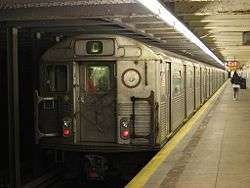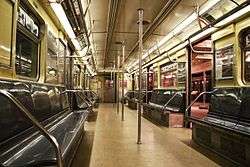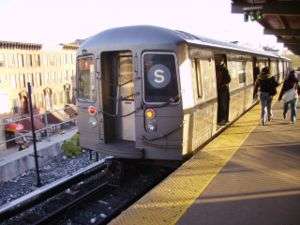R38 (New York City Subway car)
| R38 | |
|---|---|
|
An R38 train on the | |
|
Interior of an R38 car. | |
| In service | 1966-2009 |
| Manufacturer | St. Louis Car Company |
| Built at | St. Louis, Missouri, USA |
| Constructed | 1966–1967 |
| Entered service | August 23, 1966 |
| Refurbishment | 1987–1988 |
| Scrapped | 2008-2009 |
| Number built | 200 |
| Number preserved | 2 |
| Number scrapped | 198 |
| Formation | Married Pairs |
| Fleet numbers | 3950–4149 |
| Capacity | 50 (seated) |
| Operator(s) | New York City Subway |
| Specifications | |
| Car body construction | Stainless Steel sides with Carbon Steel chassis, roof and underbody, with fiberglass top front and top rear bonnets. |
| Car length | 60 ft (18.29 m) |
| Width | 10 ft (3.05 m) |
| Height | 12.08 ft (3.68 m) |
| Platform height | 3.76 ft (1.15 m) |
| Doors | 8 |
| Maximum speed | 55 mph (89 km/h) |
| Weight | 77,420 lb (35,117 kg) |
| Traction system | General Electric (GE) SCM 17KG192AE2/H7 propulsion system using General Electric (GE) 1257E1 (115 hp or 86 kW per axle) |
| Braking system(s) | WABCO E2 "SMEE" Braking System, A.S.F. simplex unit cylinder clasp (tread) brake |
| Track gauge | 4 ft 8 1⁄2 in (1,435 mm) |
The R38 was a New York City Subway car model built from 1966 to 1967 by the St. Louis Car Company in Missouri for the IND/BMT B Division.
Description
The R38s were numbered 3950-4149. The cars were built to supply extra trains for the Chrystie Street Connection, which opened on November 27, 1967.
The cars were arranged in "married pairs" of two cars semi-permanently coupled together by a linkbar. Like the R32s before them, the R38s had body siding made of stainless steel. Even-numbered cars were known as "B" cars or trailer cars, while odd-numbered cars were known as "A" cars or cab cars.
The R38 was the first subway car fleet to have air conditioning installed. The last ten cars delivered (4140–4149) came factory equipped with Stone Safety 10-ton split system air conditioning system featuring the compressor/condenser units mounted under the cars, and the evaporator units were installed on the top interior ends of same in 1967. The experiment was finally a success after past failures and air conditioning would soon, but not immediately, become standard equipment on new rolling stock built for the system, since the first 200 R40 cars were built without air conditioning. From this point on, the New York City Transit Authority (NYCTA) began adopting air conditioning as standard equipment on all new cars, as well as some slightly older model cars retrofitted with same to make life much more bearable throughout the subway system. This Stone Safety Air Conditioning system was adopted from their standard railroad coach or commuter coach air conditioning systems used very successfully.
The R38s were similar to the R32s, but had several differences, including a New York City Transit Authority seal on the cab ends, being half-fluted (up to the side windows) instead of fully fluted, larger number plates with a different font, and a different interior design that was similar to that in R32s 3800-3949.
History
In 1965 the New York City Transit Authority, continuing its program of car replacement, ordered 200 additional cars for the B Division from the Saint Louis Car Division of General Steel Industries at the cost of $22,000,000.[1]
The first two trains of R38s were placed in service at Queens Plaza after a brief introductory ceremony attended by Mayor John V. Lindsay, NYCTA Chairman Joseph O'Grady, and NYCTA Commissioners Joseph Gilhooly and Daniel T Scanell on the E and F on August 23, 1966. Though there were controversies about diverting these cars from their original assignment for the D, the IND Queens Boulevard Line was short of cars and the R1-R9s assigned to Jamaica Yard were in a worse state of disrepair.
In 1987–1989, all R38s except for cars 3990-3991 & 4000-4001 (which were involved in two different incidents in June 1972 in the Coney Island Yard and in 1983 the 207th Street Yard, respectively)[2][3][4] were rebuilt by General Electric at its Buffalo, New York facility. During the rebuilding process, the R38s were fully equipped with air conditioning systems. Prior to rebuilding, the R38s featured mylar curtain route signs on their bulkheads displaying the service bullet and destination, similar to past B-Division R-type cars. After rebuilding, they received Luminator flipdot signs that displayed the service letter only, since the air conditioning evaporators mounted on the interior car ends made it rather difficult to change the front route and destination rollsigns.
Retirement
The R160 order has replaced the entire fleet of R38s. The first cars were taken out of service in November 2008, and the fleet was gradually phased out until the last pair (4098-4099) made its final trip on the C in March 18, 2009. All cars, except for the four cars scrapped after accidents and cars 4028-4029, were stripped and sunken as artificial reefs.
Cars 4028-4029 are preserved for the New York Transit Museum.[5] They were restored to operating status in 2013-2014 and have been operating on New York City Transit Museum-sponsored excursions since August 2014.
In popular culture
The scene on a subway train in Coming to America was shot on an R38. Also, the opening scene of the movie Saturday Night Fever shows a train of R38s on the B. Both scenes show the R38 before it was refurbished.
The trains on the video game Grand Theft Auto IV are based on both the R38s and R32s.
References
- ↑ Annual Report 1964–1965. New York City Transit Authority. 1965.
- ↑ "Showing Image 5027". nycsubway.org.
- ↑ "Showing Image 5028". nycsubway.org.
- ↑ "Showing Image 5029". nycsubway.org.
- ↑ "Showing Image 144513". nycsubway.org.
Further reading
- Sansone, Gene. Evolution of New York City subways: An illustrated history of New York City's transit cars, 1867–1997. New York Transit Museum Press, New York, 1997 ISBN 978-0-9637492-8-4
External links
| Wikimedia Commons has media related to R38 (New York City Subway car). |




